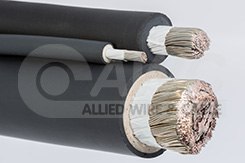DLO vs Welding Wire | Product Knockout
May 18, 2016 Leave a comment
 Our Product Knock-out series is a match-up between two similar products. In boxing terms, think same weight class, same caliber, and same level of experience and amount of exposure. The purpose of these posts are for you to see a side-by-side view of two similar products, and to be able to understand which one will be crowned champ for your specific purposes. Take your seats and prepare for battle, because the gloves are coming out.
Our Product Knock-out series is a match-up between two similar products. In boxing terms, think same weight class, same caliber, and same level of experience and amount of exposure. The purpose of these posts are for you to see a side-by-side view of two similar products, and to be able to understand which one will be crowned champ for your specific purposes. Take your seats and prepare for battle, because the gloves are coming out.
DLO cable and welding wire are typically placed in the same category and are both used in power supply applications. But what exactly are these two cables and why are they frequently compared? To uncover their similarities and differences, let’s take a look at the construction and electrical specs for both DLO cable and welding wire, as well as the applications they’re used in.
What is DLO cable?
DLO cable stands for Diesel Locomotive Operations cable, and as the name implies, its primary uses are related to the operation of diesel-powered train locomotives. Overall, it’s a very rugged power cable, which is why DLO cable can also be found in oil and gas rigs, power supply systems, shipyards, and motor leads.
Because DLO is used in many power supply applications, it has a high voltage rating of up to 2000V. The cable is also rated to 90°C in both wet and dry applications and is available from 14 AWG to 1111.0 MCM. In terms of the cable’s construction, DLO cable features a stranded tinned copper conductor and a double jacket. The power cable offers either EPR or EPDM insulation, and features a CPE outer jacket.
What is welding wire?
Welding wire, which is also referred to as grounding wire, is a portable cord typically used for welding and power supply applications, and is also suitable for use in battery and marine applications. Weld wire is rated for up to 600V and for use from -50°C to 105°C depending on jacket material, the most common of which are EPDM, EPR, and Neoprene. Welding wire features a single annealed bare copper conductor that’s finely stranded for daily industrial use, and is typically known for its flexibility and versatility. The cable also resists tears, cuts, and abrasion.
DLO vs Welding Wire
Although both DLO cable and weld wire are suited for use in similar applications, there are a few characteristics that set them apart and can make a big difference when trying to decide which type of cable will best meet your needs. Both feature stranded conductors, but welding wire offers a bare copper conductor with a higher strand count, making it more flexible, but also harder to terminate. DLO uses a tinned copper conductor, which increases resistance to corrosion and fares better in outside environments over a longer period. DLO cable also features a double jacket which protects against weather and impact.
When discussing jacket colors, welding wire most often comes in red and black, although it’s available in blue, green, and yellow too. However these colors are not as common. It’s also available in orange, which indicates an even more durable welding cable construction. DLO cable is only available in black, but can also carry multiple-ratings including UL RHH/RHW-2 as well as CSA R90, making it available for use in a wider variety of applications. Keep in mind that when DLO cable is used as RHH/RHW-2 or R90, the voltage ratings change to 600V and 1000V, respectively.
Winner by unanimous vote? Instead, it seems as if the match has ended in a technical decision. In this case it looks like our crowned champ depends on your specific application use.
When deciding between the two cables, it’s important to remember that DLO cable has more capabilities and higher ratings that make it better suited for heavier duty power supply applications. For a more detailed look at DLO cable and weld wire, view our full listings or give your sales rep a call at 800-472-4655.


